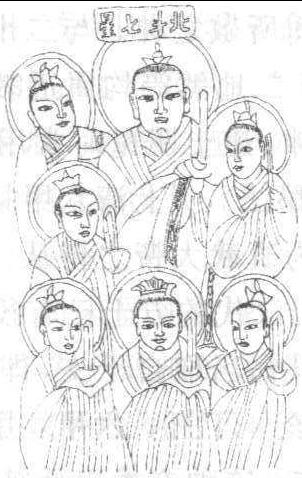《北斗》beidou
现代文学月刊,中国左翼作家联盟的机关刊物之一。1931年9月创刊于上海。丁玲主编。《北斗》在“左联”领导下,积极配合当时的革命实际斗争,既注重宣传革命文艺理论,又大力刊登进步文学作品,同时也发表具有积极意义的翻译作品。《北斗》曾发表过鲁迅、瞿秋白等人的很多杂文,还发表了冰心、徐志摩、戴望舒、沈从文、丁玲、穆木天、张天翼等不同风格作家的各类作品,充满了强烈的时代气息,反映了广泛而深刻的社会问题。《北斗》还经常展开文艺理论问题的探讨,参与组织了当时关于文艺大众化的重要讨论,发表了冯雪峰、周扬、郑振铎等人的理论文章,有力促进了革命文艺理论的发展。
作为“左联”的重要机关刊物,《北斗》在白色恐怖的严峻形势下,密切联系和团结了广大进步作家,培养了很多文艺新人,促进了无产阶级革命文学运动的蓬勃发展,它在现代文学期刊史上占有重要地位。
北斗běidǒu
一种道教徒所戴的冠帽。北斗是民间普遍信仰的神祗,为道教中司长人间寿夭的神。三国魏曹植《与陈孔璋书》:“夫披翠云以为衣,戴北斗以为冠。”明谢肇淛《五杂俎》卷一二:“北斗,道冠也。”
北斗
民间所敬之神。属道教所奉的主寿夭之神。北斗崇拜在星辰崇拜中地位突出,这是由于它与人们生活有密切联系。古人很早就认识到北斗七星不但是夜间指示方位的极好标志,而且其运行规律对于制定历法大有作用。所以到汉代,将其人神化,谓即黄帝。同时,也将许多社会功能强加给它。如《史记·天官书》称“以齐七政”,《尚书大传》谓指四时、天文、地理、人道,纬书更谓其主州国分野、年命寿夭、富贵爵禄、岁时丰歉。早期道教吸收了这种信仰,重新调整了分工,让它专掌寿夭,“北斗注死”之说遂兴。后有“鬼官北斗君”之称,亦由此衍化而来。隋唐以后,由于佛教的地藏、阎罗信仰广为流传,遂使北斗之神职有所变化,而出现了本命神之说,以为北斗七星分掌诸生辰,只要虔奉本命辰之星,即可获神佑。在将北斗星神人格化的过程中,有多种说法,而影响较大的,则出自元明间道士的编造,谓周御王妃紫光夫人一胎生九子,二长子为天皇大帝、紫微大帝,七幼子则为北斗七星。据《道藏》之《玉清无上灵宝自然北斗本生真经》,七星名贪狼、巨门、禄存、文曲、廉贞、武曲、破旱。而紫光夫人遂被称为斗姆,其像三目四首,左右各四臂。

北斗
北斗
彩色电影故事片。长春电影制片厂1979年出品。编剧:胡苏;导演:周予;摄影:阎序中、段振江;主要演员:黄中秋、李元华、王润身。故事梗概: 1933年,陕北农民谢福祥老人为生活所迫、忍痛将孙女桂兰送进恶霸地主大院。青年歌手申长源自幼与桂兰青梅竹马,心心相印。为使桂兰逃出火坑,长源与桂兰仓促成婚,带上父亲留下的唢呐和板胡离开了家乡。夫妻乞讨卖唱,来到陕北边塞重镇。军阀甘文戍见桂兰年轻貌美,将二人收入 “凤翔社”戏班。桂兰色艺双绝,甘文戍垂涎不已。一日,甘将桂兰骗入小洋房,试图奸污未遂。在艺人帮助下,长源、桂兰逃出城外。慌乱中长源跌下沟崖,桂兰被追兵抓回,触柱身亡。1935年,申长源得遇陕北红军交通员安兆祥,并在安启发下明白了革命道理,决定前往投奔刘志丹。该片于1979年获全国优秀影片奖。
北斗
恒星。北部天空排列成斗勺状的7颗亮星。7颗星到地球距离不等,在60~200光年(1光年=9.46×1012km)之间。勺口边的两颗星连线延伸约5倍的地方,有北极星。随季节不同,每晚黄昏时间人们看到勺柄所指的位置也在变化:春季指东,夏季指南,秋季指西,冬季指北。俗话说的“斗转星移”,形容时光流转,季节更替。